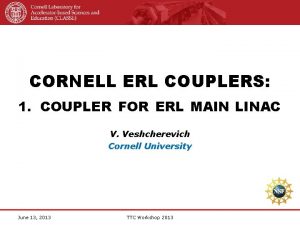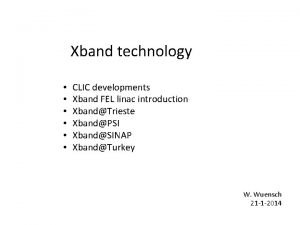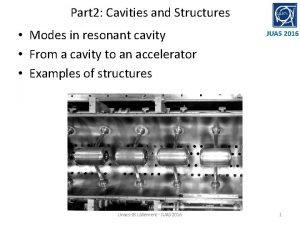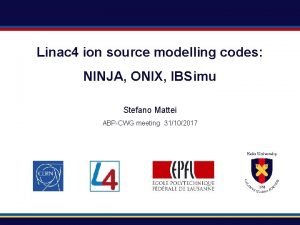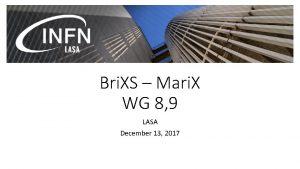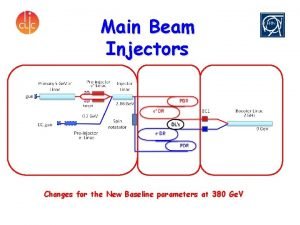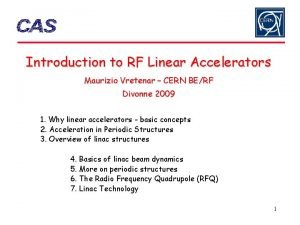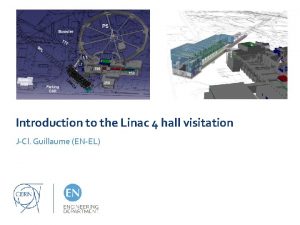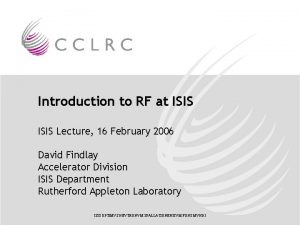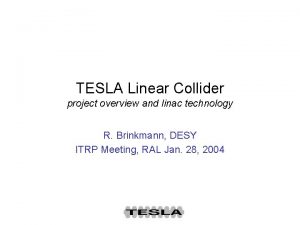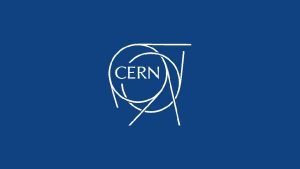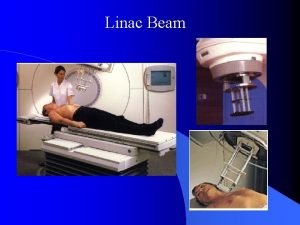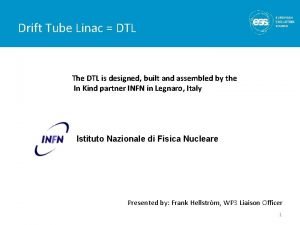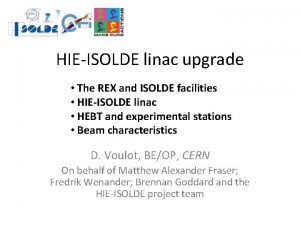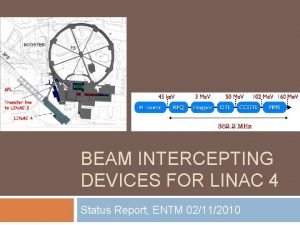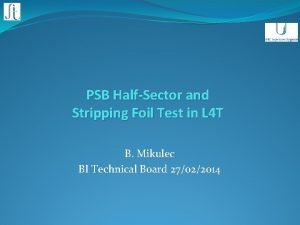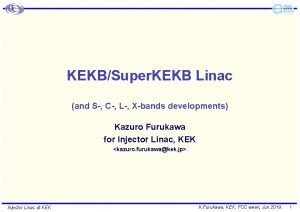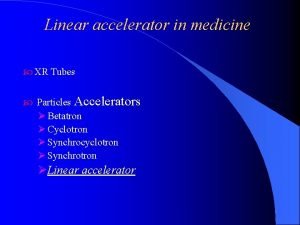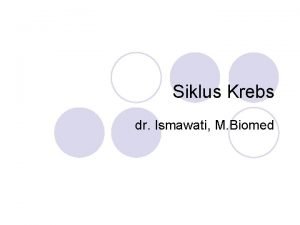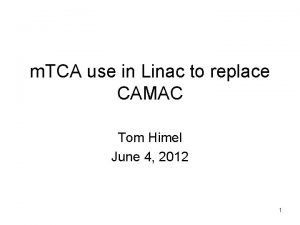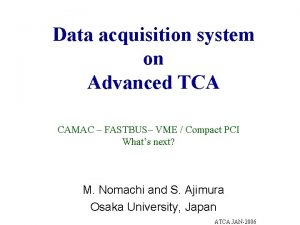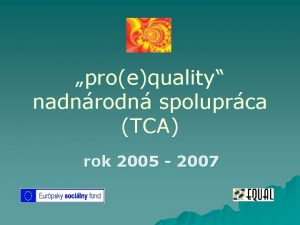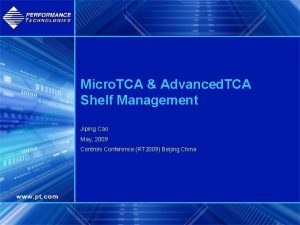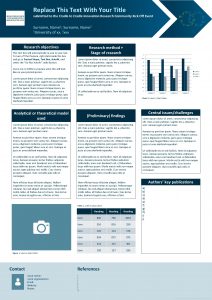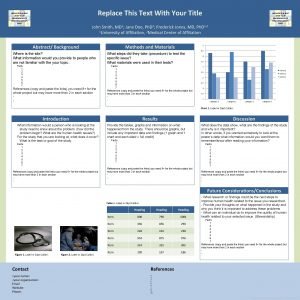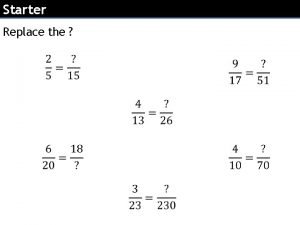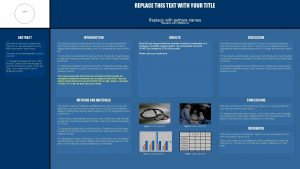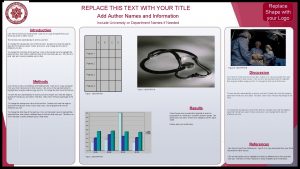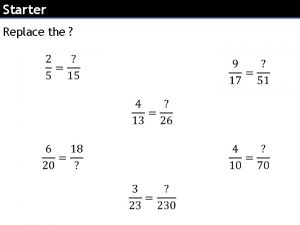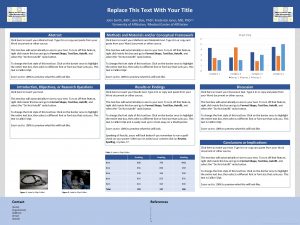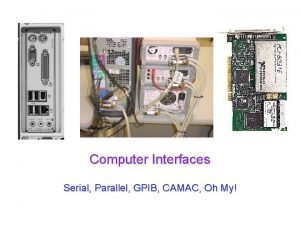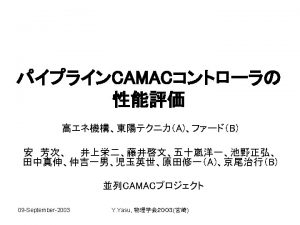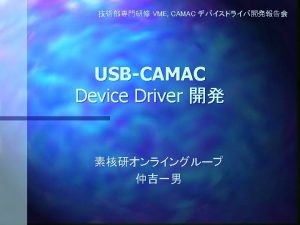m TCA use in Linac to replace CAMAC



















- Slides: 19

m. TCA use in Linac to replace CAMAC Tom Himel June 4, 2012 1

Outline • General plan for replacing the linac CAMAC. • Can it be done without disrupting the accelerator run schedule? • Budget and schedule 2

General plan (1 of 3) • As mentioned in my introductory talk: – Had planned to replace CAMAC in sectors 10 -20 during four 7 month long annual downtimes of FACET. – This would save cost of doing the phase I upgrade for LCLS-II – Would allow LCLS-II to start with new hardware. – Very unlikely to happen on this time-scale as all available resources are needed for upgrades more essential for LCLS-II 3

General plan (2 of 3) • Full CAMAC replacement is now far enough in the future, have not made new detailed plans. • Do want intermediate improvements to be compatible with future plans – E. g. LCLS-II linac needs BPMs with better resolution and lower charge sensitivity than present CAMAC readout. – Best if done with final architecture so infrastructure can be shared with other systems and have best modern hardware 4

General plan (3 of 3) • If lab decides to use sectors 1 -10 for FACET-II followed by LCLS-III, will propose to do those 10 sectors first during the long downtimes of FACET, then spread to rest of linac after we have all procedures down pat. • Otherwise will start in LCLS I or II sectors during down days and the 2 month annual downtimes. • Systems where we are happy with LCLS-I solution will mostly be duplicated. Systems with no or problematic LCLS-I solutions will be redone, typically in m. TCA • High channel count systems are the most important to develop early. 5

Plans by system • LLRF: – LCLS-I still depends on CAMAC. PADs and PACs supplement the CAMAC on a few stations. All interlocks, timing and some analog readings are done with PIOP and MKSU – Replace with m. TCA and MKSU-II (interlock and diagnostic network attached device (NAD) developed as part of the LLRF AIP project) • BPM: – Upgraded linac LCLS-I has VME + NAD which works well. Cannot do 2 bunch, very kludgey. – Replace CAMAC with m. TCA. – Present CAMAC system inadequate for low current running. 6

Plans by system • Quads/Bends: – Upgraded linac LCLS uses NAD which works well – Duplicate – Present CAMAC + rack mounted controller solution has regulation problems at low current. • Correctors – Upgraded linac LCLS uses VME ADC and DAC and PLC to control 2 bulk supplies and 16 corrector channels. Works fine but expensive – AIP developing new controller that goes in the crate with the 16 channels and replaces the VME and PLC functionality. Makes the power supply crate a NAD similar to that for the Quad power supply controller – Will use the AIP solution 7

Plans by system • Machine Protection – Upgraded linac LCLS uses home-brew “link node” chassis that has plug in cards some of which are COTS, others are home-brew. Works well. – Will probably duplicate as requirements are odd enough that COTS solution is unlikely • Vacuum: – LCLS non-linac uses signal conditioning chassis + COTS PLC’s – duplicate 8

Plans by system • Temperatures and other slow ADCs – LCLS non-linac uses Beckoff I/O. Cheap, works well. – Duplicate • Digital I/O – LCLS non-linac uses IP cards on VME carrier board – Will use same IP cards on m. TCA carrier. 9

Plans by system • Small channel count diagnostics like toroids, Faraday cups, profile monitors, wire scanners – LCLS solutions have various problems – Will improve for LCLS-II as allowed. – For toroid would build a new RTM for same ADC used for LLRF – Linac upgrade will either duplicate the improved versions or, if needed, develop improved versions probably in m. TCA. 10

Installation without disruption • We have considerable experience at this. • Process: – Test in lab – Test in part of linac not in use – Where possible (not too many cables), develop quick switch over from old to new and back – Install and test on down days • Phase I was done this way with virtually no disruption of accelerator program. See “Changing horses mid-stream” at http: //www. esrf. eu/icalepcs 2011/papers/tucau st 04. pdf 11

Installation without disruption • Most RF stations can be taken offline, worked on and put back online while the linac is running. Main exceptions are injector klystrons. • The m. TCA LLRF testing was done this way using cable adaptors to make the switching of cables quick. • Some systems like vacuum and MPS will have to have their final connections made during the two month downtimes. 12

Cost comparision • The two biggest (and hence most expensive) systems are LLRF and BPMs. • They are also the only systems for which we have seriously looked at more than one solution. • Dan and Qiao showed that the costs for the considered solutions were quite similar • Expect the same to be true for other locations of the same types of hardware 13

Linac upgrade cost and schedule • As I mentioned before, we have not updated the cost and schedule for upgrading the linac as the start date is distant and uncertain. • I’ll show some of what we presented at the last review. • Mention a few possible changes 14

Budget Cost Analysis • Resource Cost Estimates – All tasks detailed – Resources identified – Discussed details w/ resources for estimates – Summed resources vs. draft schedule – Performed similar exercise for RF (already approved AIP) – Totaled all manpower costs vs. time (24 mo. )

Hardware Cost Estimates • MTCA Infrastructure – COTS based on actual quotes or vendor budgetary quotes – Includes crate, power modules, Hub Controller, Processor IOC, Timing Module – Timing module not yet a commercial item but base cost on similar commercial products

Hardware Costs 2 • Applications Modules – AMCs: ADC-DAC, 3 -IP, PMC adapter • ADC-DAC: Vendor quotes, DESY target (Strück); Vadatech quote pending • 3 -IP: quote in hand (TEWS) • PMC: Quotes pending (Vadatech, TEWS) – US 2 nd sources: • Buying first articles to specification, compatible RTM – Timing • Source is Stockholm U. , working to develop vendors

Estimated 10 Sector Cost 1440 T. Himel q Assume LI 11 -20 Column costs q Solid state subbooster required q Modulator PLC not required 13110 q BCS & Power Supplies Included q RF Station Unit Cost = $28 K

Summary • The R&D for the major systems is well advanced. • We still have a few implementation decisions to make on the minor systems • We have a rough and somewhat out of date cost estimate • We have experience doing upgrades during short downtimes and while this one involves more cables, it is still doable 19
